What is visible light? A small sliver of the electromagnetic spectrum that defines human experience and connects art with science and humanity with the universe.
Table of Contents
Introduction
Light has always fascinated humankind. From the flickering flames of ancient oil lamps to the dazzling brilliance of stars in the night sky, light is more than mere illumination. It is the very essence of how you perceive the universe.
Light has always fascinated humankind. From the flickering flames of ancient oil lamps to the dazzling brilliance of stars in the night sky, light is more than mere illumination.
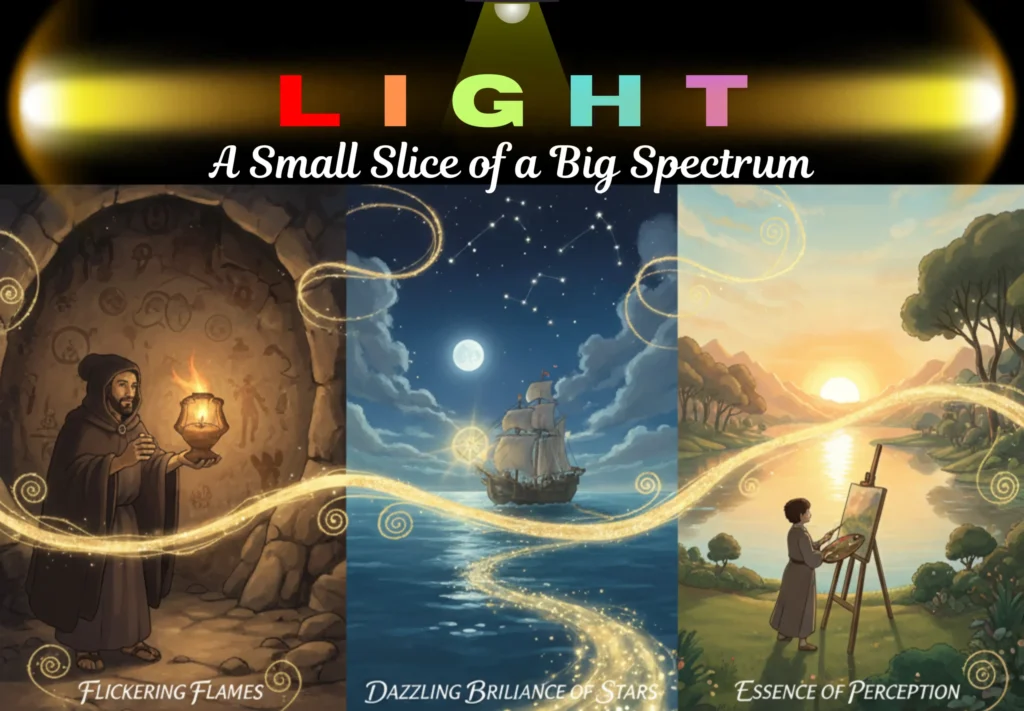
Light is the very essence of how you perceive the universe. It shapes art, science, and guides explorers, painters, and thinkers alike. Every sunrise and every reflection on a still pond tells a silent story written in light.
What is Visible Light?
The visible light is a tiny fraction of the large electromagnetic spectrum.
Within this tiny fraction of the electromagnetic spectrum lies every colour you cherish. Every sunrise you adore, every piece of art and science that touches your vision, light reminds us that greatness often hides in smallness.
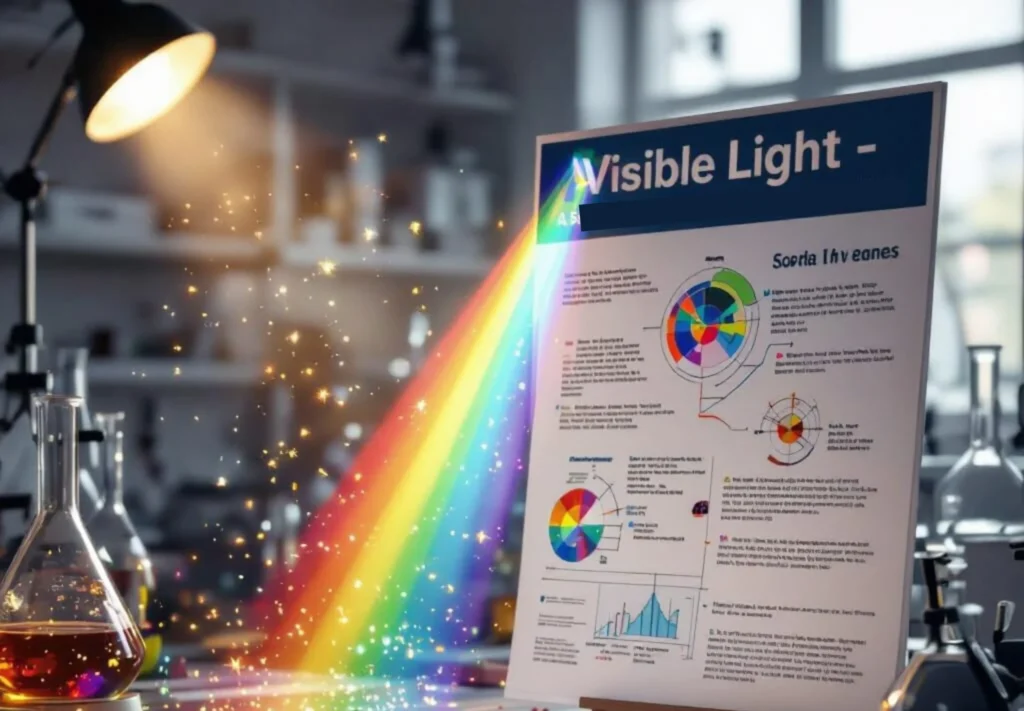
Luminous Objects vs Non-Luminous Objects
| Property | Luminous Objects | Non-Luminous Objects |
| Definition | Objects that produce their own light. | Objects that do not produce light but become visible by reflecting light from luminous sources. |
| Examples | Sun, stars, electric bulbs, candles, fireflies. | Moon, planets, trees, buildings, books, humans. |
| Energy Source | Convert other forms of energy (like chemical, electrical, or nuclear) into light energy. | Do not generate light energy on their own. |
| Visibility | Can be seen even in complete darkness because they emit light. | It can be seen only when illuminated by a luminous source. |
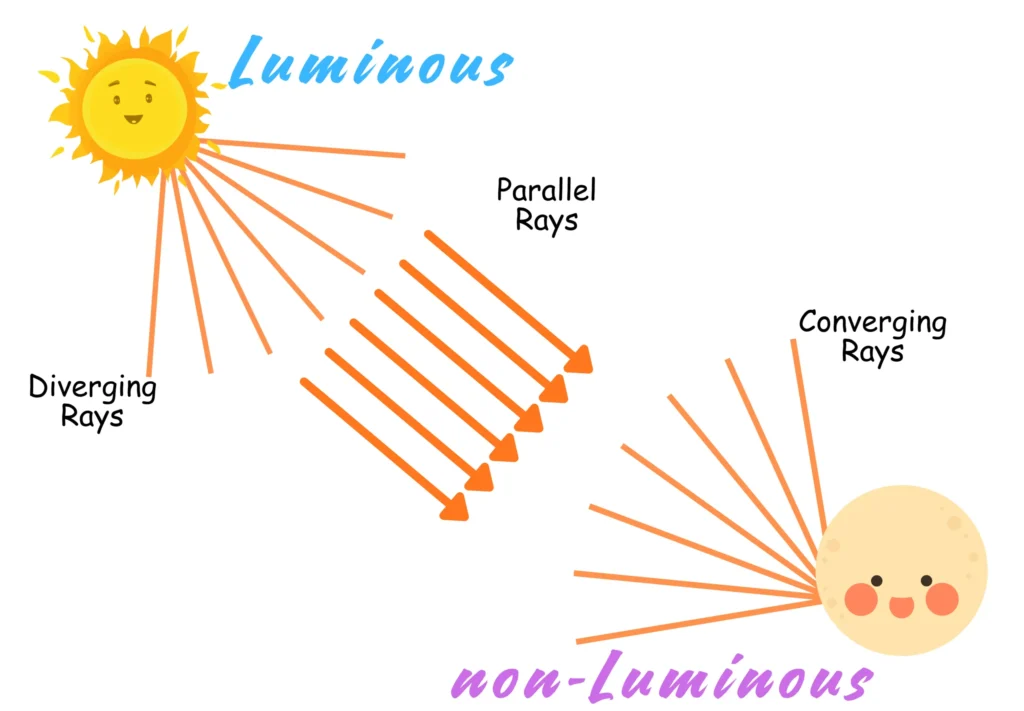
Luminous objects create light; non-luminous objects share it.
What is Optics?
The study of visible light is known as optics. It is one of the oldest and most elegant branches of physics. It is defined as:
“The branch of physics that seeks to understand not just what light is, but also how it behaves, i.e.;
- how it bends
- how it reflects
- how it disperses
- how it reveals the hidden colours that compose the visible world”

Light is the bridge between the physical world and perception.
&
Optics is the science that studies that bridge.
Rays, Beams, and the Birth of Optics
Long before prisms and quantum theories, the study of light began with simple observations of how light travels in straight lines — as rays and beams.
The idea of light rays dates back to ancient Greek philosophers like Euclid and Ptolemy. However, it was Ibn al-Haytham (Alhazen, 965–1040 CE) who truly revolutionised the field.
Ibn al-Haytham was a brilliant scholar of the Islamic Golden Age. He laid the scientific foundation of modern optics through his monumental work, Kitab al-Manazir (The Book of Optics). He was the first to explain that vision occurs when light rays reflect from objects and enter the eyes.
Ibn al-Haytham overturned the old Greek idea that eyes emit rays themselves.
To prove his theories, he developed one of the earliest pinhole cameras, known as the Camera Obscura. It was a darkened place with a small hole that projected an inverted image of the outside world onto an inside surface.
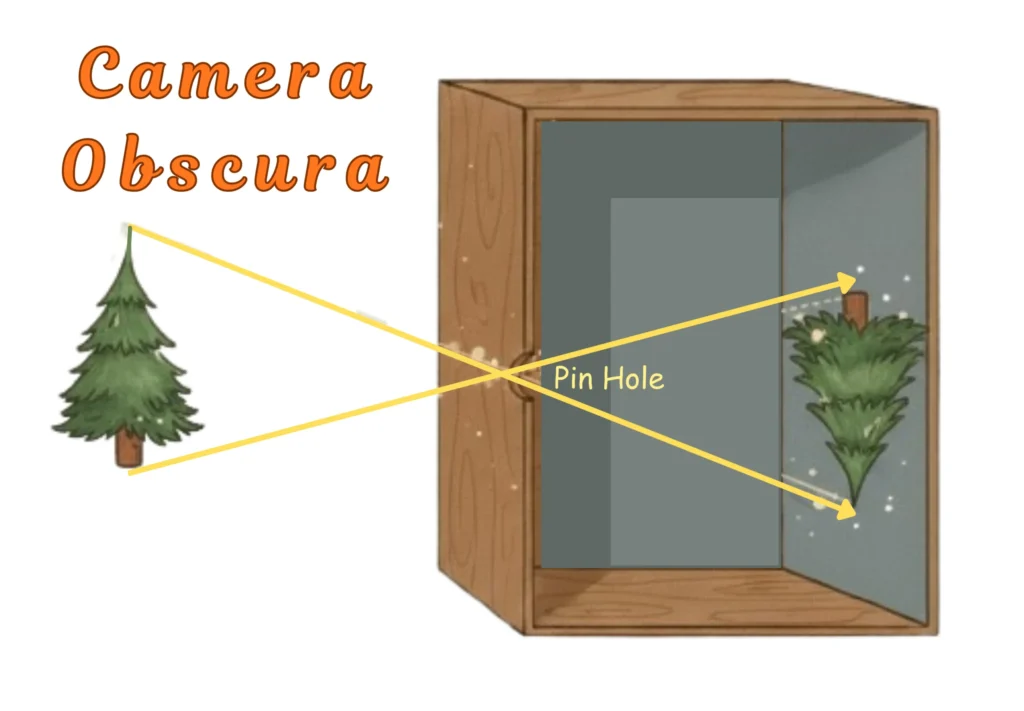
This simple yet profound experiment showed how light travels in straight lines and how images form. This is the very principle that underlies modern photography and cameras today.
Beyond his camera experiments, Ibn al-Haytham also:
- Explained reflection and refraction using geometric principles.
- Studied how lenses and curved mirrors affect light rays.
- Introduced experimental verification into optics
Ibn al-Haytham’s revolutionary steps transformed optics from philosophy into science.
Ibn al-Haytham’s work inspired later thinkers such as Roger Bacon, Kepler, and Newton, bridging ancient ideas with the dawn of modern physics.
The Nature of Light | A Dual Personality
For centuries, scientists pondered whether light was made of waves or particles.
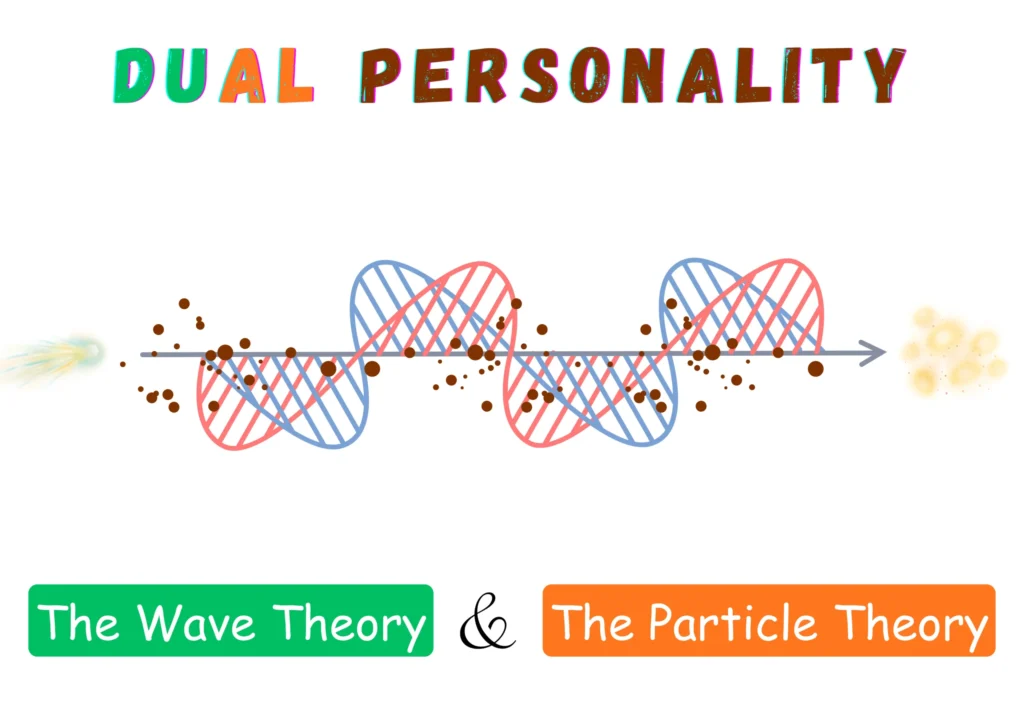
The Wave Theory
The wave theory of light was first proposed by Christiaan Huygens and later strengthened by the experimental work of Thomas Young and Augustin-Jean Fresnel. Their combined efforts demonstrated that light behaves as a wave, characterised by oscillating electric and magnetic fields.
This understanding laid the foundation for what we now describe as electromagnetic waves (EM waves).
These waves can stretch across vast distances, vibrating at an incredible speed. Their defining features determine what kind of light we perceive or detect. These features include:
- Wavelength (the distance between peaks)
- Frequency (how many peaks pass per second)
The Particle Nature of Light
Then came a revolution
In the early 20th century, Max Planck and Albert Einstein came up with the idea of the corpuscular nature of light. They proposed that light also behaves as a stream of discrete packets of energy called photons. Each photon carries a specific amount of energy, directly proportional to its frequency.
The Birth of the Dual Nature of Light
Light, in essence, refuses to be boxed into a single form. It behaves both like a ripple and a bullet all at once. It can bend through a prism, yet knocks electrons free in metals. This dual nature — both wave and particle — gives light its mysterious versatility.
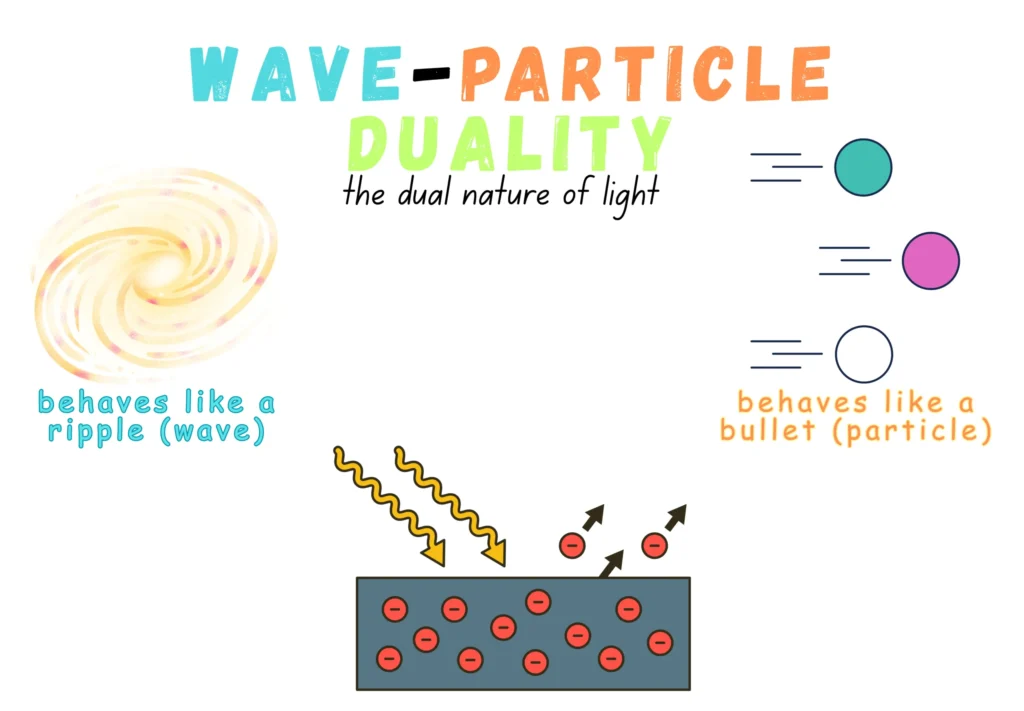
The Grand Electromagnetic Spectrum
Light, as you see it, is but a whisper in a vast cosmic symphony. The electromagnetic spectrum stretches from the longest, laziest radio waves to the shortest, energetic gamma rays.
Most of these forms of light are invisible to the human eye, as it cannot perceive those wavelengths. Yet, these unseen waves shape our daily lives. For instance:
- Radio waves carry our voices across continents
- Microwaves warm our food
- X-rays peer into our bones

Visible light is a narrow window of frequencies nestled in between this immense range of EMWs. It is the spectacular portion of EMW that paints our world.
| Region | Wavelength Range | Frequency Range | Common Examples |
| Radio waves | > 1 m | < 3×10⁸ Hz | Broadcasting, communication |
| Microwaves | 1 m – 1 mm | 3×10⁸ – 3×10¹¹ Hz | Microwave ovens, radar |
| Infrared (IR) | 1 mm – 700 nm | 3×10¹¹ – 4×10¹⁴ Hz | Remote controls, heat lamps |
| Visible light | 700 – 400 nm | 4.3×10¹⁴ – 7.5×10¹⁴ Hz | What human eyes can see |
| Ultraviolet (UV) | 400 – 10 nm | 7.5×10¹⁴ – 3×10¹⁶ Hz | Sunlight, sterilisation |
| X-rays | 10 – 0.01 nm | 3×10¹⁶ – 3×10¹⁹ Hz | Medical imaging |
| Gamma rays | < 0.01 nm | > 3×10¹⁹ Hz | Radioactive decay, cosmic rays |
From the fiery glow of red at 700 nm to the deep, cool violet around 400 nm, every hue you admire is but a different vibration of the same phenomenon.
Visible Light | The Spectrum of Sight
Visible light represents a minute fraction of the electromagnetic spectrum, spanning roughly between 400 and 700 nanometres. It defines the perception of reality as the human eye is adapted to this narrow band. Sunlight itself shines most intensely in this region EM Spectrum.
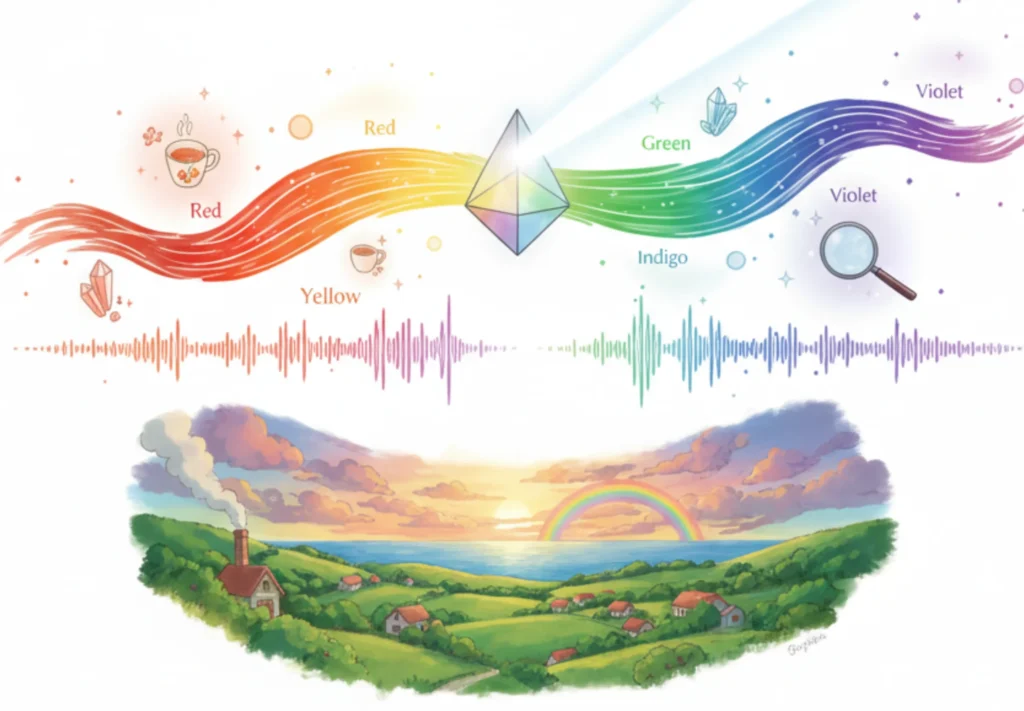
What you call colour is, in truth, your brain’s interpretation of different wavelengths of light.
The Symphony of Colours
When sunlight passes through a prism, it unfurls into a spectrum and gives a graceful gradient of colours:
Red, Orange, Yellow, Green, Blue, Indigo, and Violet
Each colour carries a distinct energy.
- Red waves are long and lazy, spreading warmth and calm.
- Violet is short and sharp, pulsating with intensity.
Together, they form the natural palette that paints sunsets, rainbows, and oceans.
Light in Motion
Light travels at a staggering speed of 3 × 10⁸ meters per second in a vacuum. This speed is considered the ultimate speed limit of the universe. Yet, as it enters materials like water or glass, it slows down slightly. This change in speed causes it to bend, a phenomenon known as refraction.

The bending of light is the very thing that makes rainbows curve, lenses focus, and the world appear so visually rich. Without refraction, you would have no eyeglasses, cameras, or telescopes. Most importantly, without it, your understanding of the cosmos would remain blurry and incomplete.
The Importance of Visible Light
Visible light is not just a tool of sight; it is the heartbeat of life.
- Artists use it to craft beauty.
- It defines our circadian rhythms, guiding sleep and wake cycles.
- Scientists harness it in lasers and fibre optics to transmit information.
- It fuels photosynthesis, turning sunlight into food and oxygen, the very foundation of the ecosystem.

In a world dominated by invisible radiation, visible light remains the most intimate as you live with it and understand it instinctively.
Beyond the Visible Horizon
Optics today extends far beyond glass lenses. It ventures into photonics, quantum optics, and nanotechnology, where light manipulates atoms, transmits data, and drives innovation. Visible light may be a small slice, but it is the gateway to understanding the entire spectrum of EMW.
Conclusion
Optics, the study of light, does more than just decode a physical phenomenon. It celebrates our connection to the cosmos. Studying it not only helps us see the world more clearly but also understand the invisible forces that govern it.
Exploring light means exploring the universe itself.
Frequently Asked Questions (FAQs)
What is visible light in the electromagnetic spectrum?
Visible light is the portion of the electromagnetic spectrum that can be detected by the human eye, typically spanning wavelengths from 400 to 700 nanometres.
Why is visible light important?
Visible light enables vision, fuels photosynthesis, regulates human circadian rhythms, and is vital for technologies like lasers, fibre optics, and imaging systems.
What are the main colours of visible light?
The visible spectrum consists of red, orange, yellow, green, blue, indigo, and violet—each representing a different wavelength of light.
What is the difference between visible light and invisible light?
Visible light can be perceived by the human eye, while invisible light (like infrared or ultraviolet) lies outside the 400–700 nm range and requires special detectors.
Who discovered that light has both wave and particle nature?
The dual nature of light was developed through contributions from scientists like Huygens, Young, Fresnel, Max Planck, and Albert Einstein.
How fast does light travel?
Light travels at approximately 3 × 10⁸ meters per second in a vacuum, known as the universal speed limit.
What causes the colours in a rainbow?
Rainbows form when sunlight refracts, reflects, and disperses through raindrops, splitting into its component wavelengths.
What is optics in physics?
Optics is the branch of physics that studies the behaviour, properties, and interactions of light, including reflection, refraction, and dispersion.
What are photons?
Photons are discrete packets of energy that make up light, each carrying energy proportional to its frequency.
How is visible light used in everyday life?
Visible light is used in lighting, photography, vision, communication systems, medical imaging, and the creation of visual art.

